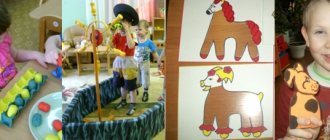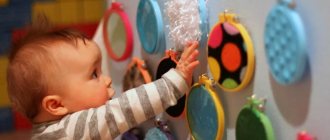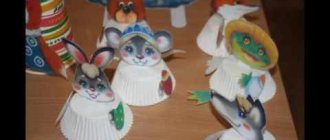SYSTEM OF DIDACTICAL GAMES AND EXERCISES FOR FORMING ORDICAL COUNTING SKILLS
SYSTEM OF DIDACTICAL GAMES AND EXERCISES FOR FORMING ORDICAL COUNTING SKILLS
Matryoshka dolls
Target:
practice ordinal counting, develop attention and memory.
Material:
colored scarves (5 – 10 pcs.)
Content:
The driver is selected. Children tie scarves and stand in a row - these are nesting dolls. They are counted out loud in order: “First, second, third, etc.” The driver remembers where each nesting doll is and goes out the door. At this time, two nesting dolls change places. The driver enters and says what has changed, for example: “The red nesting doll was fifth, but became second, and the second became fifth.” Sometimes the nesting dolls can remain in their places.
Rules of the game:
The driver should not spy on how the nesting dolls change places. The driver cannot be given any hints. If the driver correctly notices how the nesting dolls have swapped places, then he appoints one of them as the driver, and he himself becomes a matryoshka.
Take your place
Target:
practice ordinal counting and tactile counting.
Material:
two sets of cardboard cards with buttons sewn on them in a row - from two to ten.
Content:
The players stand in a row, hands behind their backs, with ten chairs in front of them. The teacher distributes cards to everyone. Children count the buttons and remember their number. At the presenter’s signal: “Numbers! Get in order!" Each of the players stands behind a chair, the serial number of which corresponds to the number of buttons on his card. The players show cards and the presenter checks whether they took their places correctly.
Rules of the game:
Count buttons only behind your back. The number of buttons on the card is the child's serial number. If someone believes that his serial number is the one that is already occupied, then he stands behind the child standing in this place. Anyone who is in the wrong place is asked to jump 3 times, or jump 4 steps on one leg, or clap their hands 5 times.
Game option:
You can put the same cards on the chairs as for children. The players must find a card with the same number of buttons as they count by touch.
Make no mistake
Target:
Exercise children in quantitative and ordinal counting.
Material:
for each child, a strip of thick paper, divided into ten squares: ten small cards, equal to the size of the square on the strip of paper, with circles from one to ten depicted on them.
Game content:
Children place strips of paper and small cards in front of them. The presenter calls a number, and the children must find a card, the serial number of the square. The presenter can call numbers from 1 to 10 in any order. As a result of the game, all small cards must be arranged in order: from one to ten.
Didactic games for learning ordinal and quantitative calculations for older children
Didactic games for learning ordinal and quantitative calculations for older children
"Pick up a toy"
Goal: to practice counting objects by the named number and memorizing it, to learn to find an equal number of toys. Content. V. explains to the children that they will learn to count out as many toys as he says. He calls the children one by one and gives them the task of bringing a certain number of toys and placing them on one table or another. Other children are instructed to check whether the task has been completed correctly, and to do this, count the toys, for example: “Seryozha, bring 3 pyramids and put them on this table. Vitya, check how many pyramids Seryozha brought.” As a result, there are 2 toys on one table, 3 on the second, 4 on the third, and 5 on the fourth. Then the children are asked to count out a certain number of toys and place them on the table where there are the same number of such toys, so that it can be seen that there are equal numbers of them. After completing the task, the child tells what he did. Another child checks whether the task was completed correctly.
“Is it enough?”
Goal: to teach children to see equality and inequality of groups of objects of different sizes, to bring them to the concept that number does not depend on size. Content. V. offers to treat the animals. First he finds out: “Will the bunnies have enough carrots and the squirrels have enough nuts? How to find out? How to check? Children count the toys, compare their numbers, then treat the animals by placing small toys next to large ones. Having identified an equality and inequality in the number of toys in the group, they add the missing item or remove the extra one.
"Which Got Away"
Purpose: To train children in ordinal counting
.
Progress of the game
: Invite the children to build a ladder of 4 steps and put one toy on each step. They agree to count the steps from below. Child
turns away, the adult removes one toy. Turning around, the child must say which toy is missing.
"Errand"
Purpose: To exercise children
in the ability to count objects according to
named number, name the numeral, agreeing
with a noun.
Progress of the game
: The adult names a number familiar to the child.
The child brings the same number
of toys and names them. Then the child names the number and completes the assignment.
adult. An adult needs to make mistakes from time to time, but no more than by 1. For each correctly completed assignment, the player receives a chip.
"At the Poultry Farm"
Goal: to exercise children in counting within limits, to show the independence of the number of objects from the area they occupy. Content. V.: “Today we will go on an excursion to a poultry farm. Chickens and chickens live here. There are 6 hens sitting on the top perch, and 5 chicks on the bottom perch. Compare hens and chickens and determine that there are fewer chickens than hens. “One chicken ran away. What needs to be done to get an equal number of hens and chicks? (You need to find 1 chicken and return it to the chicken). The game repeats itself. V. quietly removes the chicken, the children look for a mother hen for the chicken, etc.
Best math games
The goal of the didactic game “Numbers” is the formation of primary mathematical concepts.
- acquaintance with the world of numbers, with forward and backward counting, simple arithmetic operations;
- developing the ability to compare objects by quantity;
- consolidation of the concept of “one” and “many”, “less” and “more”;
- training in analysis, comparison, and the ability to relate a number to the number of objects;
- development of memory, concentration, reaction speed, thinking and speech abilities.
Digital puzzles
Place the halves of the cards representing numbers in a pile on the table upside down. Distribute the other halves of the images equally among the game participants. Choose the first player with a counting rhyme.
The child takes a picture from the pile, names the sign, and looks to see if it has the correct half. If missing, puts the card back, and the right to choose passes to the next player.
The halves are fastened in pairs with a “lock”, like in a puzzle. This bond determines the correctness of the choice.
The winner of the game is the participant who is the first to find the other halves for their cards.
Learning from 0 to 10
Games for numbers 1 and up to 10 are useful for preschoolers. They help remember the number series and reinforce forward and backward counting. Lesson options:
- Place cards in a row representing 0 to 10. Say the task that the child must complete. For example, “remove 8”, “cover the sign between 3 and 5 with your palm” or “show what is greater than 2 by 3”.
- Cut the pictures with signs from 1 to 10 into two parts. Mix the lower parts into a pile. Let the child connect the pictures to make the correct image.
- Throw the ball to the players in turn, calling from 1 to 9. The person who caught it says the next number after the name and throws the ball back.
- Prepare a picture of a steam locomotive with 10 carriages. Sign the trailers, except for one. The player's task is to name the missing number. The game can be organized as a paired competition, then the winner is the one who gives the correct answer first.
Collect the petals
For the game, prepare petals with arithmetic problems and flower cores with answers. Invite students to attach the petals according to the problem solved.
The game can be made competitive. Divide the participants into two groups. The winner is the one who attaches the correct petals faster.
Much and little
Give the children three pictures: the first has 5 balls, the second has 3, the third has 1. When you say “a lot,” the participants must pick up a card with five objects. When “not enough” - with three. When “one” – with a single ball.
Forest Glade
For the game, prepare an image of a clearing surrounded by trees and separate cards with forest objects in a certain number. Give your child tasks: “count the trees”, “hang 5 cones on the spruce”, “place 3 mushrooms under the tree” and others.
Vegetable shop
Give participants cards with numbers. Ask the store to buy a similar number of products. Place pictures on the table depicting different quantities of vegetables. The player’s task is to find a picture with the number of vegetables corresponding to the card.
Remember the number and number
For the didactic game “Number and Digit”, prepare cards with mathematical signs. First, place three pictures in front of the player and ask them to remember. Then connect the cards with the rest of the images, mix them, and the child must remember what numbers he saw, find them in the pile, and arrange them in the original sequence.
Next, complicate the task, ask you to memorize 4, 5, 6, 7 cards, and so on up to ten. If the child is familiar with the numbers of the second ten, you can make an appropriate selection.
Let's treat the squirrel
For the game, prepare images of nuts and mushrooms, marked from 1 to 10, and two strings. Place a toy or a picture of a squirrel in front of the children, ask them to help the forest guest and collect a treat for her. Have the players attach nuts to one string in forward order (from 1 to 10), and mushrooms to another in reverse order (from 10 to one).
To make the task more difficult, ask children to collect only even or odd numbers, first in forward order, then in reverse order.
To test the task, ask the players to say the numbers in the order in which they are attached to the ropes.
Find the number
For the didactic game “Find the Number,” attach to the board pictures depicting objects in different quantities. Make a riddle, for example: “The beds are our home, and in the greenhouse we grow like exhibits in a museum, on the branches are red... (tomatoes).” Children guess, find the corresponding picture, count how many tomatoes are shown, and pick up a card with a number.
Instead of a riddle, you can describe objects. For example: “This is a pet, smart, loyal, responds to a name, lives in a kennel, loves to chew bones (dog).”
Magic figures
To play, draw geometric shapes on a sheet of paper:
- circle(0);
- triangle (3);
- square (4);
- pentagon (5);
- hexagon (6).
Tell the children that the evil sorcerer turned the numbers into figures. To remove witchcraft, ask to count the number of angles in each shape.
You can make the activity creative. Let the child become a kind wizard, choose a figure, try to turn it into some object, drawing on the details with pencils. For example, a circle in a face.





